Controls of Zeolite Development on Reservoir Porosity from Lower Permian Formations in Shawan and Its Adjacent Areas, Western Junggar Basin
Abstract
1. Introduction
2. Geological Setting
3. Sampling and Analytical Program
3.1. Sample Sources
3.2. Clastic Rock Composition Analysis
3.3. X-Ray Diffraction (XRD) Analysis
3.4. Scanning Electron Microscopy with Energy-Dispersive Spectroscopy (SEM-EDS)
4. Results
4.1. Sediment Composition Differences Between Shawan Sag and Adjacent Areas
4.2. Zeolite Types in the Shawan Sag and Adjacent Areas
4.2.1. Laumontite Mineralogy
4.2.2. Heulandite Mineralogy
4.2.3. Analcime Mineralogy
5. Discussion
5.1. Contrast in Genesis of Zeolites Between the Shawan Sag and Adjacent Areas
5.2. Contrast in Pore Types Between the Shawan Sag and Adjacent Areas
5.3. Impact of Zeolites on Petrophysical Properties
5.4. Controls of Zeolite Genesis on Pore Types in the Shawan Sag and Adjacent Areas
6. Conclusions
- Significant differences exist in sediment source compositions between the Shawan Sag and adjacent areas (Chepaizi, Zhongguai). The Shawan Sag is dominated by tuff fragments with relatively high quartz content, whereas adjacent areas feature andesite fragments with substantially higher plagioclase content. Whole-rock XRD analyses further confirm quartz predominance in the Shawan Sag versus plagioclase dominance in adjacent areas. These provenance differences directly drive mineral enrichment contrasts, establishing the foundation for divergent zeolite genesis and pore systems.
- Zeolite types and origins in the study area are controlled by sediment source compositions. The Shawan Sag primarily develops laumontite, heulandite, and minor analcime, formed through hydration of volcanic glass in tuff: clinoptilolite → analcime → heulandite → laumontite. Adjacent areas exhibit zeolites generated by albitization of plagioclase in andesite fragments, with released Ca2+ providing the material basis for laumontite precipitation.
- Zeolite genetic differences between the Shawan Sag and adjacent areas shape pore system differentiation. In the Sag, zeolite evolution involves mineral density changes and crystalline water release, resulting in pore systems dominated by grain-edge fractures. In adjacent areas, the albitization of plagioclase and the transformation of laumontite to calcite provide the material basis for subsequent dissolution, resulting in a pore type dominated by intergranular dissolution pores. Provenance differences control both zeolite genesis mechanisms and pore type differentiation.
- The zeolite evolution pathway via volcanic glass hydration produces dissolution-resistant heulandite, constraining reservoir quality enhancement. Conversely, the albitization of Ca-rich plagioclase inhibits quartz precipitation by consuming SiO2, and under elevated pCO2 conditions, facilitates the transformation of laumontite to soluble calcite. This transformation enhances reservoir quality by generating easily dissolvable minerals.
Author Contributions
Funding
Data Availability Statement
Acknowledgments
Conflicts of Interest
Abbreviations
| XPL | Cross-Polarized Light |
| PPL | Plane-Polarized Light |
| SEM | Scanning electron microscopy |
| SEP | Secondary Electron Photomicrographs |
| EDS | Energy-dispersive spectroscopy |
| XRD | X-ray diffraction |
Appendix A
| Well | Area | Formation | Depth (m) | Lithology | Number of Thin Sections | Number of XRD | Number of SEM-EDS |
|---|---|---|---|---|---|---|---|
| sp002 | Shawan Sag | Fengcheng Formation (P1f) | 4514.27~4517.87 | Sandy conglomerate | 4 | ||
| sp002 | 4689.07~4693.6 | Sandy conglomerate | 4 | ||||
| sp14 | 5543.32~5549.06 | Sandy conglomerate | 2 | ||||
| sp16 | 4877.7~5087.7 | Sandy conglomerate | 5 | ||||
| sp2 | 5555.31~5559.85 | conglomerate | 3 | ||||
| sp3 | 4693.3~4698.72 | Sandy conglomerate | 3 | 1 | |||
| sp3 | 4718.27~4721.7 | Sandy conglomerate | 3 | 3 | |||
| sp4 | 4354.57 | Sandy conglomerate | 1 | ||||
| sp5 | 4658.68~4781.07 | Sandy conglomerate | 5 | ||||
| st002 | 5400.15~5407.29 | Sandy conglomerate | 5 | 2 | |||
| st2 | 5720.71~5725.64 | conglomerate | 3 | 3 | 4 | ||
| st2 | 5539.18~5542.78 | conglomerate | 5 | 2 | 6 | ||
| st2 | 5495 | conglomerate | 1 | ||||
| cp24 | 4600.07~4610.98 | Sandy conglomerate | 3 | 2 | |||
| zj14 | Zhongguai Uplift | Jiamuhe Formation (P1j) | 4294.89~4302 | Sandy conglomerate | 13 | 4 | |
| zj141 | 4335.34~4341.88 | Sandy conglomerate | 8 | 2 | |||
| zj141 | 4403.3~4410.66 | Sandy conglomerate | 5 | 2 | |||
| zj15 | 4042.7~4050.2 | Sandstone | 4 | 3 | |||
| zj4 | 4407.74 | Sandy conglomerate | 1 | 1 | |||
| zj4 | 4408.3~4413.6 | Sandy conglomerate | 5 | 1 | |||
| zj4 | 4436.98~4445.37 | Sandy conglomerate | 10 | 1 | 2 | ||
| zj4 | 4465.72~4473.91 | Sandy conglomerate | 3 | ||||
| zj4 | 4537.52~4543.15 | Sandy conglomerate | 6 | 4 | 1 | ||
| zj4 | 4628.39~4634.21 | Sandy conglomerate | 5 | 1 | 2 | ||
| zj5 | 3884.11 | Sandy conglomerate | 1 | ||||
| zj6 | 4880.45~5597.55 | Sandy conglomerate | 15 | ||||
| zj7 | 4000.7~4339.52 | Sandy conglomerate | 3 | ||||
| zj903x | 4726.32~4733.2 | Sandy conglomerate | 3 | ||||
| cp001 | Chepai Uplift | Jiamuhe Formation (P1j) | 2331.73~2417.99 | Sandy conglomerate | 2 | ||
| cp002 | 2655.23~2779.13 | Sandy conglomerate | 2 | 1 | |||
| cp004 | 2962 | conglomerate | 1 | ||||
| cp005 | 2851.3~2858.2 | Sandy conglomerate | 3 | ||||
| cp005 | 2972.59 | Sandy conglomerate | 1 | ||||
| cp10 | 3492.5 | Sandy conglomerate | 1 | ||||
| cp18 | 2437.4~2455.8 | conglomerate | 3 | ||||
| cp19 | 2772~2777.42 | conglomerate | 1 | 1 | |||
| cp21 | 2527.43~2538.5 | Sandy conglomerate | 2 | 1 | |||
| cp27 | 4456.65~4459.17 | Sandy conglomerate | 2 | ||||
| cp2 | 2836.63 | Sandy conglomerate | 1 | ||||
| cp5 | 4670.99~4673.92 | conglomerate | 3 | ||||
| cp5 | 4704.25~4709.18 | conglomerate | 5 | ||||
| cp5 | 4732.71~4734.14 | conglomerate | 1 | 1 |
| Well | Area | Formation | Depth (m) | Gravel Content/% | ||||||
|---|---|---|---|---|---|---|---|---|---|---|
| QG | FG | TG | AG | GG | FELG | BG | ||||
| sp002 | Shawan Sag | Fengcheng Formation (P1f) | 4514.27 | 2 | 7 | 49 | 23 | / | / | / |
| sp002 | 4515.42 | 1 | 7 | 53 | 18 | / | / | / | ||
| sp002 | 4516.69 | / | 5 | 62 | 13 | / | / | / | ||
| sp002 | 4517.85 | / | 5 | 53 | 20 | 1 | / | / | ||
| sp002 | 4689.07 | 1 | 4 | 58 | 20 | / | / | / | ||
| sp002 | 4690.28 | / | 4 | 52 | 17 | / | / | / | ||
| sp002 | 4692.91 | 1 | 7 | 59 | 10 | / | / | / | ||
| sp002 | 4693.6 | 5 | 11 | 43 | 7 | 2 | / | / | ||
| sp14 | 5543.32 | 2 | 4 | 75 | 6 | / | 1 | / | ||
| sp14 | 5549.06 | / | 2 | 13 | 62 | / | / | / | ||
| sp16 | 5087.7 | 2 | 22 | 38 | 10 | / | 3 | / | ||
| sp16 | 4877.7 | / | / | 63 | / | / | / | / | ||
| sp16 | 4906.3 | / | 4 | 43 | 19 | / | 1 | / | ||
| sp16 | 4939.4 | / | 3 | 56 | 27 | / | / | / | ||
| sp16 | 4976.3 | / | 3 | 19 | 55 | / | / | / | ||
| sp2 | 5555.31 | 1 | 9 | 54 | 7 | 1 | / | / | ||
| sp2 | 5557.13 | 4 | 12 | 45 | 4 | / | / | / | ||
| sp2 | 5559.85 | 8 | 13 | 59 | / | 2 | / | / | ||
| sp3 | 4693.3 | 4 | 5 | 54 | 37 | / | / | / | ||
| sp3 | 4718.27 | 15 | 17 | 41 | 12 | / | / | / | ||
| sp3 | 4695.61 | 1 | 8 | 67 | 6 | / | / | / | ||
| sp3 | 4698.4 | 1 | 5 | 68 | 6 | / | / | / | ||
| sp3 | 4719.14 | 2 | 7 | 50 | 8 | 1 | / | / | ||
| sp3 | 4721.7 | 1 | 13 | 50 | 14 | / | / | / | ||
| sp5 | 4659.98 | / | 1 | 60 | 21 | / | / | / | ||
| sp5 | 4662.28 | / | / | 63 | 17 | / | / | / | ||
| sp5 | 4664.72 | / | 2 | 79 | 3 | / | / | / | ||
| sp5 | 4778.82 | / | 1 | 73 | 2 | / | / | / | ||
| sp5 | 4780.9 | 2 | 6 | 64 | 11 | 1 | / | / | ||
| st002 | 5400.15 | / | / | 75 | 2 | / | / | / | ||
| st002 | 5404.55 | / | 1 | 59 | 18 | 2 | / | / | ||
| st002 | 5407.29 | 1 | / | 77 | 2 | / | / | / | ||
| st002 | 5401.28 | / | 1 | 46 | 31 | 1 | / | / | ||
| st002 | 5404.86 | / | / | 57 | 27 | 1 | / | / | ||
| st2 | 5722.5 | 6 | 5 | 68 | / | / | / | / | ||
| st2 | 5720.71 | 8 | 5 | 68 | / | / | / | / | ||
| st2 | 5541.18 | 5 | 4 | 52 | / | 10 | / | / | ||
| st2 | 5539.18 | 5 | 6 | 51 | 20 | / | / | / | ||
| st2 | 5540.2 | / | / | 52 | 24 | / | / | / | ||
| st2 | 5495 | 5 | 8 | 70 | 2 | / | / | / | ||
| st2 | 5539.65 | / | 1 | 35 | 43 | / | / | / | ||
| st2 | 5541.93 | / | 2 | 46 | 39 | / | / | / | ||
| st2 | 5724.21 | 3 | 5 | 56 | 20 | / | / | / | ||
| cp24 | 4600.07 | 5 | 6 | 45 | 38 | / | / | / | ||
| cp24 | 4604.89 | 10 | 8 | 60 | 15 | / | / | / | ||
| cp24 | 4610.98 | 10 | 25 | 50 | 12 | / | / | / | ||
| zj14 | Zhongguai Uplift | Jiamuhe Formation (P1j) | 4294.89 | / | / | 11 | 61.1 | / | / | 1 |
| zj14 | 4295.49 | / | / | 17 | 56.4 | / | / | 1 | ||
| zj14 | 4296.45 | 2 | 3 | 16 | 52.3 | / | / | / | ||
| zj14 | 4296.85 | 2 | 2 | 2 | 5/.5 | / | / | / | ||
| zj14 | 4297 | 2 | 2 | 17 | 51.5 | / | / | / | ||
| zj14 | 4297.12 | / | / | 8 | 62.5 | / | / | / | ||
| zj14 | 4297.3 | / | / | 9 | 58.4 | / | / | / | ||
| zj14 | 4297.4 | / | 1 | 11 | 49.1 | / | / | / | ||
| zj14 | 4297.66 | / | 1 | 13 | 48.5 | / | / | / | ||
| zj14 | 4298.06 | / | 1 | 11 | 49.8 | / | / | / | ||
| zj14 | 4298.6 | / | 2 | 14 | 47.6 | / | / | / | ||
| zj14 | 4301.16 | / | 1 | 16 | 44.7 | / | / | / | ||
| zj14 | 4302 | / | 2 | 13 | 55.5 | / | / | / | ||
| zj141 | 4335.34 | / | 1 | 5 | 49.4 | / | / | / | ||
| zj141 | 4335.78 | / | 2 | 16 | 44.1 | / | / | / | ||
| zj141 | 4338.36 | / | 2 | 11 | 58.4 | / | / | / | ||
| zj141 | 4338.94 | / | 2 | 1 | 62.9 | / | / | / | ||
| zj141 | 4339.19 | / | 2 | 12 | 58 | / | / | / | ||
| zj141 | 4339.54 | / | 2 | 5.5 | 61.2 | / | / | / | ||
| zj141 | 4341.36 | / | 2 | 1 | 68 | / | / | / | ||
| zj141 | 4341.88 | / | 3 | 4 | 69 | / | / | / | ||
| zj141 | 4403.3 | / | 1.2 | 7 | 47 | / | / | / | ||
| zj141 | 4406.16 | / | 2 | 1 | 67.3 | / | / | / | ||
| zj141 | 4407.73 | / | 1 | 9 | 64 | / | / | / | ||
| zj141 | 4409.71 | / | 1 | 11 | 61.3 | / | / | 8 | ||
| zj141 | 4410.66 | / | 1 | 5 | 77.5 | / | / | 2 | ||
| zj15 | 4048.99 | 9.5 | 44.7 | 9 | 4.6 | / | / | / | ||
| zj15 | 4049.68 | 10.3 | 46.4 | 5 | 3.6 | / | / | / | ||
| zj15 | 4049.85 | 8 | 46.4 | 2.1 | 7 | / | / | / | ||
| zj15 | 4050.2 | 1 | 48 | 7 | 3 | / | / | / | ||
| zj4 | 4407.74 | 1 | 1 | 5 | 54 | / | / | / | ||
| zj4 | 4408.3 | 1 | 1 | 6 | 52 | / | / | / | ||
| zj4 | 4410.06 | 4 | 5 | 17 | 37.2 | / | 7 | 2 | ||
| zj4 | 4411.16 | 1 | 1 | 4 | 56.8 | / | / | / | ||
| zj4 | 4412.56 | 1 | 1 | 5 | 51.7 | / | / | / | ||
| zj4 | Zhongguai Uplift | Jiamuhe Formation (P1j) | 4537.52 | 1 | 2 | 4 | 55.7 | 1 | 3 | / |
| zj4 | 4538.53 | 1 | 2 | 3 | 58.9 | 1 | 2 | / | ||
| zj4 | 4539.53 | 7 | 6 | 2 | 48.2 | / | 2 | / | ||
| zj4 | 4540.03 | 7 | 6 | 7 | 41.3 | / | 2 | / | ||
| zj4 | 4542.15 | 7 | 7 | 6 | 44.1 | / | 2 | / | ||
| zj4 | 4543.15 | 8 | 7 | 7 | 42.2 | / | 1 | / | ||
| zj4 | 4628.39 | 8 | 7 | 6 | 42.3 | / | / | / | ||
| zj4 | 4628.82 | 7 | 6 | 5 | 38 | / | 1 | / | ||
| zj4 | 4633.29 | 2 | 1 | 3 | 36.5 | / | 1 | / | ||
| zj4 | 4633.61 | 2 | 1 | / | 39.3 | / | 3 | / | ||
| zj4 | 4634.19 | 2 | 1 | 1 | 39 | / | 3 | / | ||
| cp004 | Chepai Uplift | Jiamuhe Formation (P1j) | 2962 | / | 2 | 33 | 46 | / | / | 2 |
| cp005 | 2851.3 | 1 | 3 | 20 | 61 | / | 1 | / | ||
| cp005 | 2852.83 | / | 4 | 22 | 54 | / | / | / | ||
| cp005 | 2858.2 | 4 | 5 | 26 | 48 | / | 1 | / | ||
| cp005 | 2972.59 | 1 | 3 | 38 | 48.2 | / | / | 3 | ||
| cp19 | 2777.42 | 3 | 3 | 16 | 67 | 1 | / | / | ||
| cp21 | 2532.5 | 2 | 2 | 29 | 43 | 0.8 | / | / | ||
| cp21 | 2538.5 | 0.8 | 2.2 | 29 | 66 | / | / | / | ||
| cp27 | 4456.65 | / | 2 | 2 | 89 | / | / | / | ||
| cp27 | 4459.17 | / | 1 | 1 | 96 | / | / | / | ||
| cp5 | 4670.99 | 1 | 27 | 18 | 45 | / | 2 | / | ||
| cp5 | 4671.23 | 3 | 1 | 24 | 49 | / | 3 | / | ||
| cp5 | 4673.92 | 3.1 | 5 | 18 | 34 | / | 5 | 39 | ||
| cp5 | 4704.25 | 2.7 | 7 | / | 50 | 10 | / | / | ||
| cp5 | 4705.52 | 1 | 35 | 15 | 46 | / | / | 1 | ||
| cp5 | 4705.72 | 1 | 20 | 20 | 29 | / | / | 2 | ||
| cp5 | 4708.83 | 1 | 15 | 5 | 40 | / | 1 | 3 | ||
| cp5 | 4709.18 | 1.5 | 15 | 24 | 40 | 9.6 | / | / | ||
| cp5 | 4734.14 | 1.2 | 15.3 | 25 | 57 | 1 | / | 1 | ||
| Well | Area | Formation | Depth (m) | Qz | Pl | Lmt | Kfs | Cal | Dol | Hem | Anh | Ank | Anl | Sid |
|---|---|---|---|---|---|---|---|---|---|---|---|---|---|---|
| st2 | Shawan Sag | Fengcheng Formation (P1f) | 5539.5 | 34.61 | 34.61 | 9.54 | 17.9 | / | / | / | / | / | / | / |
| st2 | 5542.78 | 29.62 | 29.62 | 13.03 | 5.92 | 3.55 | 2.37 | 9.49 | 4.74 | / | / | / | ||
| st2 | 5724.21 | 66.78 | 16.08 | 0 | 13.6 | / | / | / | / | / | / | / | ||
| st2 | 5724.71 | 49.79 | 20.96 | 13.1 | 13.1 | / | / | / | / | 1.31 | / | / | ||
| st2 | 5725.64 | 63.55 | 23.34 | 11.67 | / | / | / | / | / | / | / | / | ||
| zj4 | Zhongguai Uplift | Jiamuhe Formation (P1j) | 4466.04 | 10.65 | 36.22 | 38.34 | 5.33 | 3.20 | / | 5.33 | / | / | / | / |
| zj4 | 4541.40 | 14.29 | 52.38 | 21.42 | 8.33 | 2.38 | / | 0.00 | / | / | / | / | ||
| zj4 | 4538.2 | 12.79 | 31.98 | 24.52 | 26.65 | 3.20 | / | 0.00 | / | / | / | / | ||
| zj4 | 4632.8 | 24.88 | 36.77 | 23.79 | 10.82 | 3.24 | / | / | / | / | / | / | ||
| zj4 | 4439.14 | 22.51 | 54.51 | 0.00 | 0.00 | 0.00 | / | 3.55 | / | / | 17.77 | / | ||
| zj4 | 4537.67 | 25.88 | 44.36 | 0.00 | 0.00 | 0.00 | / | 0.00 | / | / | 28.34 | / | ||
| zj6 | 4880.45 | 25.74 | 33.24 | 15.01 | 8.58 | 15.01 | / | 0.00 | / | / | / | / | ||
| zj6 | 4956.41 | 28.86 | 48.84 | 14.43 | / | 6.66 | / | 0.00 | / | / | / | / | ||
| zj6 | 5009.28 | 16.86 | 34.77 | 12.64 | / | 32.67 | / | 0.00 | / | / | / | / | ||
| zj6 | 5242.07 | 28.67 | 35.55 | 19.49 | / | 13.76 | / | 0.00 | / | / | / | / | ||
| zj6 | 5597.55 | 25.41 | 43.42 | 10.59 | 7.41 | 8.47 | / | 0.00 | / | / | / | / | ||
| zj6 | 4874.69 | 28.60 | 40.50 | 16.68 | 5.96 | 5.96 | / | 0.00 | / | / | / | / | ||
| zj6 | 4878.55 | 26.10 | 45.40 | 7.94 | 13.62 | 3.40 | / | 0.00 | / | / | / | / | ||
| zj6 | 4954.59 | 41.06 | 34.02 | 10.56 | 4.69 | 0.00 | / | 7.04 | / | / | / | / | ||
| zj6 | 4955.88 | 32.80 | 34.98 | 12.02 | 4.37 | 8.74 | / | 5.46 | / | / | / | / | ||
| zj6 | 4957.22 | 32.41 | 40.81 | 14.40 | 4.80 | 6.00 | / | 0.00 | / | / | / | / | ||
| zj6 | 5007.6 | 25.90 | 34.92 | 11.26 | 7.88 | 10.14 | / | 7.88 | / | / | / | / | ||
| zj6 | 5009.37 | 28.72 | 36.46 | 9.94 | 6.63 | 5.52 | / | 7.73 | / | / | / | / | ||
| zj6 | 5010.2 | 29.48 | 40.38 | 17.47 | 0.00 | 4.37 | / | 4.37 | / | / | / | / | ||
| zj6 | 5005.1 | 16.20 | 36.71 | 16.20 | 5.40 | 17.28 | / | 6.48 | / | / | / | / | ||
| zj6 | 5013.3 | 13.25 | 44.16 | 14.35 | 6.62 | 11.04 | / | 8.83 | / | / | / | / | ||
| zj7 | 4000.7 | 28.67 | 41.81 | 14.33 | 5.97 | 4.78 | / | 3.58 | / | / | / | / | ||
| zj7 | 4161.46 | 27.95 | 34.93 | 18.63 | 6.99 | 4.66 | / | 2.33 | / | / | / | 2.33 | ||
| zj7 | 4339.52 | 28.88 | 32.81 | 26.25 | 6.56 | 3.94 | / | 0.00 | / | / | / | / | ||
| zj5 | 3884.11 | 19.15 | 37.18 | 24.78 | 13.52 | 3.38 | / | 0.00 | / | / | / | / | ||
| cp001 | Chepai Uplift | Jiamuhe Formation (P1j) | 2331.73 | 50.86 | 33.91 | / | / | / | / | / | / | / | 8.48 | / |
| cp001 | 2417.99 | 46.33 | 43.01 | / | / | / | / | / | / | / | 3.31 | / | ||
| cp002 | 2655.23 | 49.20 | 43.24 | / | / | / | / | / | / | / | / | / | ||
| cp002 | 2779.13 | 43.55 | 36.66 | / | / | 6.87 | / | / | / | / | 10.31 | / | ||
| cp10 | 3492.5 | 16.97 | 64.26 | / | / | / | / | / | / | / | / | / | ||
| cp18 | 2437.4 | 26.71 | 51.08 | / | / | 18.58 | / | / | / | / | / | / | ||
| cp18 | 2455.8 | 33.78 | 38.61 | / | 15.69 | 10.86 | / | / | / | / | / | / | ||
| cp18 | 2455.52 | 37.71 | 41.14 | 4.57 | / | 11.43 | / | / | / | 2.29 | / | / | ||
| cp19 | 2772 | 25.66 | 62.11 | / | / | / | / | / | / | 3.74 | 6.75 | / | ||
| cp21 | 2527.43 | 52.39 | 39.92 | / | / | / | / | / | / | / | / | / |
Appendix B


References
- Zhou, Y.; Li, G. Characteristics, evolution and hydrocarbon exploration directions of composite petroleum systems in Junggar Basin. Pet. Explor. Dev. 2002, 29, 36–39. [Google Scholar]
- Zhang, Z.; Qiu, L.; Liu, W.; Wang, C.; Qiu, N.; Mao, X.; Zhang, Z.; Yang, D. Oil sources and hydrocarbon kitchen migration of oil-bearing structures on the north and south sides of the Che-Mo Paleo-uplift in the central Junggar Basin. China Geol. 2009, 36, 826–836. [Google Scholar]
- Zhou, Y.; Wang, X.; Li, K. Exploration strategy and countermeasures for natural gas resources in the Junggar Basin. Xinjiang Pet. Geol. 2001, 5, 386–389. [Google Scholar]
- Dong, G. Geochemical characteristics and oil—Source analysis of crude oil in the Shawan Sag of the Junggar Basin. J. Jilin Univ. (Earth Sci. Ed.) 2024, 54, 389–412. [Google Scholar]
- Zhang, R.; Zhang, X.; Chen, Z.; Cai, J.; Zhang, K.; Zhang, G. Diagenetic evolution characteristics and significance of zeolite minerals in sedimentary rocks. Xinjiang Pet. Geol. 2023, 44, 543–553. [Google Scholar]
- Zhu, S.; Zhang, X.; Wang, X.; Liu, Z. Diagenesis of zeolite minerals in the Permian Strata of the northwestern margin of the Junggar Basin and its significance for hydrocarbon accumulation. Sci. China Earth Sci. 2011, 41, 1602–1612. [Google Scholar]
- Wang, T.; Zhang, S.; Wu, P.; Liu, J.; Guo, H.; Zhang, S. Formation mechanisms of zeolite minerals and their influence on reservoir properties. Lithol. Reserv. 2022, 34, 175–186. [Google Scholar]
- Liu, Z.; Qiu, L.; Sun, Z.; Tang, Y.; Kong, Y.; Zhang, S. Diagenesis of zeolite minerals in the second member of Jiaolai Formation in the Zhongguai area of the Junggar Basin and its significance for hydrocarbon accumulation. J. China Univ. Pet. (Ed. Nat. Sci.) 2014, 38, 1–7. [Google Scholar]
- Han, B.; Li, X.; Li, Y.; Hu, D.; Dang, H.; Zhang, M. Petrophysical experiments on zeolite-bearing glutenite of the Permian system in the Mahu area. Well Logging Technol. 2022, 46, 397–403. [Google Scholar]
- Bai, Q.; Liu, Y.; Fan, T. Distribution and genesis analysis of laumontite in the Yanchang Formation of the Upper Triassic in the Ordos Basin. Northwestern Geol. 2009, 42, 100–107. [Google Scholar]
- Sun, J.; Yang, X.; Zheng, M.; He, W.; Chang, Q.; Wang, T. Reservoir characteristics and controlling factors of the Permian clastic rock reservoirs in the deep and ultra-deep layers of the Junggar Basin. China Pet. Explor. 2024, 29, 120–135. [Google Scholar]
- Wopfner, H.; Markwort, S.; Semkiwa, P.M. Early diagenetic laumontite in the Lower Triassic Manda beds of the Ruhuhu Basin, southern Tanzania. J. Sediment. Res. 1991, 61, 65–72. [Google Scholar] [CrossRef]
- Kralj, P.; Rychagov, S.; Kralj, P. Zeolites in volcanic-igneous hydrothermal systems: A case study of Pauzhetka geothermal field (Kamchatka) and Oligocene Smrekovec volcanic complex (Slovenia). Environ. Earth Sci. 2010, 59, 951–956. [Google Scholar] [CrossRef]
- Iijima, A. Zeolites in petroleum and natural gas reservoirs. Rev. Mineral. Geochem. 2001, 45, 347–402. [Google Scholar]
- Liu, C.; Li, Z.; Chen, M.; Liu, Z.; Qing, Y.; Zhang, R.; Yang, H.; Huang, Z.; Wang, Z.; Fu, X. Genesis of authigenic zeolites in the Middle-Upper Permian glutenite of the Fukang Sag, Junggar Basin and its influence on reservoir developmen. Sediment. Geol. Tethyan Geol. 2024, 44, 826–839. [Google Scholar] [CrossRef]
- Wang, J.; Wang, B.; Qiu, Q.; Li, Z.; Sun, Z.; Ma, L. Research progress on the genesis of zeolites and its reservoir control mechanism. Pet. Geol. Recovery Effic. 2025, 32, 29–39. [Google Scholar]
- Yan, C.; Wang, T.; Li, X.; Zhou, D.; Qi, P.; Feng, X.; Deng, C. Correction of measured physical property values for the Jiamuhe Formation reservoirs in Zhongguai uplift, Junggar Basin. Xinjiang Pet. Geol. 2021, 42, 749–755. [Google Scholar]
- Wang, H.; Tang, Y.; Chang, Q. Genesis mechanism of zeolite—Cemented glutenite reservoirs in the Jiamuhe formation of the Zhongguai Uplift in the Junggar Basin. Xinjiang Pet. Geol. 2017, 38, 281–288. [Google Scholar]
- Guo, M.; Song, J.; Xiao, Y.; Guo, H.; Zhang, Z.; Han, S. Distribution and controlling factors of zeolite cement in the permian of Zhongguai-Northwestern margin area in Junggar Basin. Acta Pet. Sin. 2016, 37, 695–705. [Google Scholar]
- Hay, R. Zeolites and Zeolitic Reactions in Sedimentary Rocks; Geological Society of America: Boulder, CO, USA, 1966; pp. 1–85. [Google Scholar]
- Chipera, S.J.; Goff, F.; Goff, C.J.; Fittipaldo, M. Zeolitization of intracaldera sediments and rhyolitic rocks in the 1.25 Ma lake of Valles caldera, New Mexico, USA. J. Volcanol. Geotherm. Res. 2008, 178, 317–330. [Google Scholar] [CrossRef]
- Noh, J.H.; Boles, J.R. Origin of zeolite cements in the Miocene sandstones, North Tejon oil fields, California. J. Sediment. Petrol. 1993, 63, 248–260. [Google Scholar]
- Chen, S.; Yang, Y.; Wang, X.; Qiu, L.; Huang, Y.; Wu, C.; Chen, S. Genesis mechanism of laumontite cement and its impact on the reservoir of siliciclastic rock: A case study of Jurassic Shaximiao Formation in central Sichuan Basin, China. Mar. Pet. Geol. 2024, 165, 106873. [Google Scholar] [CrossRef]
- Broxton, D.E.; Bish, D.L.; Warren, R.G. Distribution and chemistry of diagenetic minerals at Yucca mountain, Nye County, Nevada. Clays Clay Miner. 1987, 35, 89–110. [Google Scholar] [CrossRef]
- Aoyagi, K.; Kazama, T. Transformational changes of clay minerals, zeolites and silica minerals during diagenesis. Sedimentology 1980, 27, 179–188. [Google Scholar] [CrossRef]
- Shi, Y.; Ji, H.; Zhang, G.; Wang, J.; Sun, X.; Liu, J. Distribution characteristics and genetic mechanism of zeolites in the Wutonggou Formation reservoir on the Fudong Slope of the Junggar Basin. Pet. Sci. Bull. 2021, 6, 1–15. [Google Scholar]
- Zhang, J.; Wang, B.; Hu, Z.; Sun, F.; Li, D.; Li, Z.; Qing, Q.; Shi, Z.; Huang, Z. Genetic mechanisms of high-quality deep to ultra-deep clastic reservoirs: A case study of Permian-Triassic systems in the hinterland of Junggar Basin. Oil Gas Geol. 2025, 46, 151–166. [Google Scholar]
- Chen, S.; Yang, Y.; Qiu, L.; Wang, X.; Guo, X.; Liu, W.; Liu, J. Reservoir characteristics and controlling factors of the Jurassic Shaximiao Formation in central Sichuan area. Nat. Gas Geosci. 2022, 33, 1597–1610. [Google Scholar]
- Zhang, L. Theoretical calculation on the genesis and formation conditions of laumontite in the Yanchang Formation of the Triassic in Northern Shaanxi. Acta Petrol. Sin. 1992, 8, 145–152+208. [Google Scholar]
- Huang, S.; Liu, J.; Song, L.; Wang, W. Thermodynamic explanation of the formation conditions of laumontite in the diagenesis of clastic rocks. Geol. Rev. 2001, 47, 301–308. [Google Scholar] [CrossRef]
- Yang, X.; Qiu, Y. The formation mechanism, distribution law of laumontite in the Yanchang Formation of the Upper Triassic in Ordos Basin and its relationship with oil and gas. Acta Sedimentol. Sin. 2002, 20, 628–632. [Google Scholar] [CrossRef]
- Yang, Y.; Wang, M.; Wu, C.; Zhang, J.; Peng, K.; Zhang, H.; Wang, X.; Chen, D.; Chen, H. Genesis of calcium-rich formation water in the second member of Shaximiao Formation of Jurassic in central Sichuan area and its indication significance for natural gas migration and accumulation. Oil Gas Geol. 2025, 46, 178–191. [Google Scholar]
- Yuan, Z.; Zhang, Y.; Yang, H.; Yang, X.; Liu, W. Characteristics of laumontite cement in the Yanchang Formation on the Southeastern margin of the Ordos Basin and its diagenetic model. J. Northwest Univ. (Nat. Sci. Ed.) 2020, 50, 124–134. [Google Scholar]



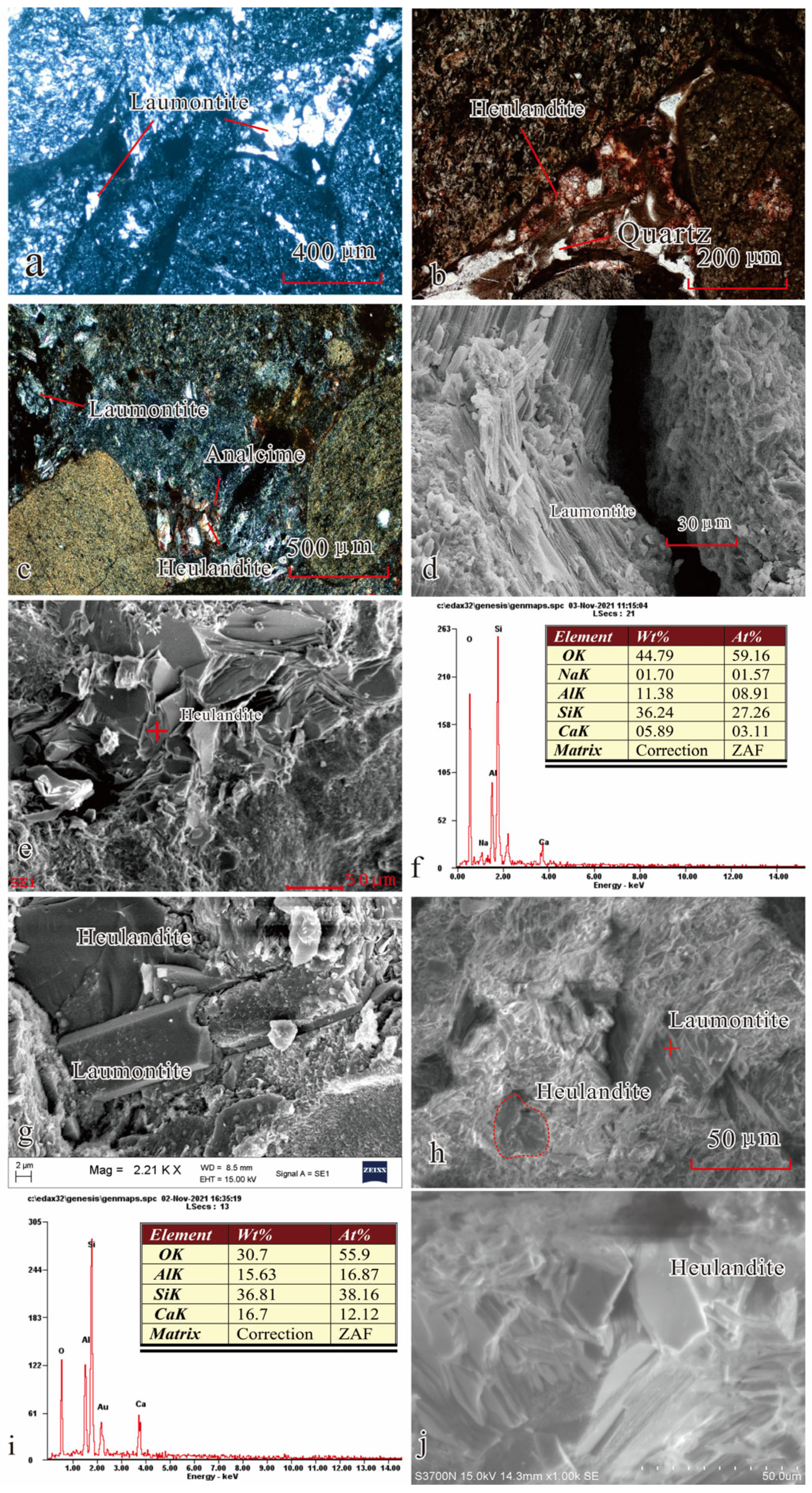
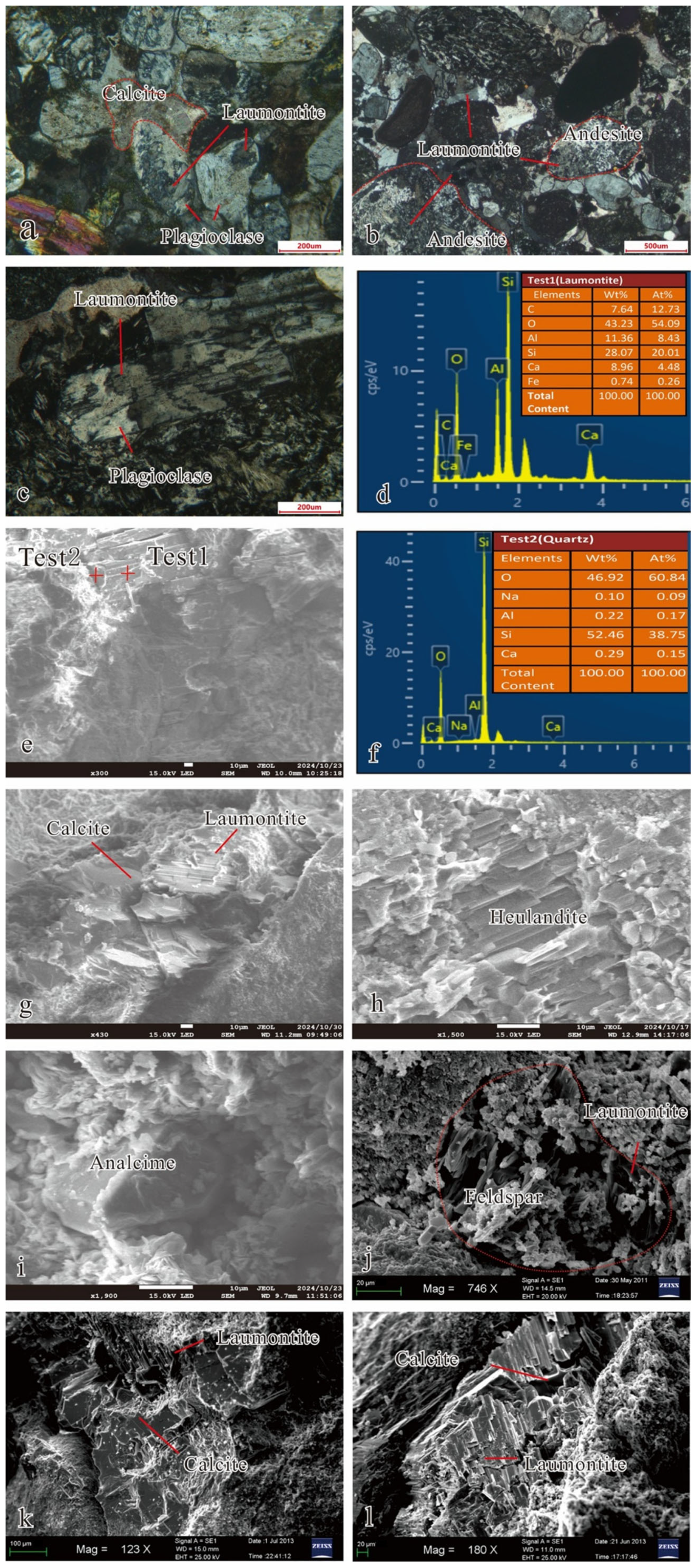
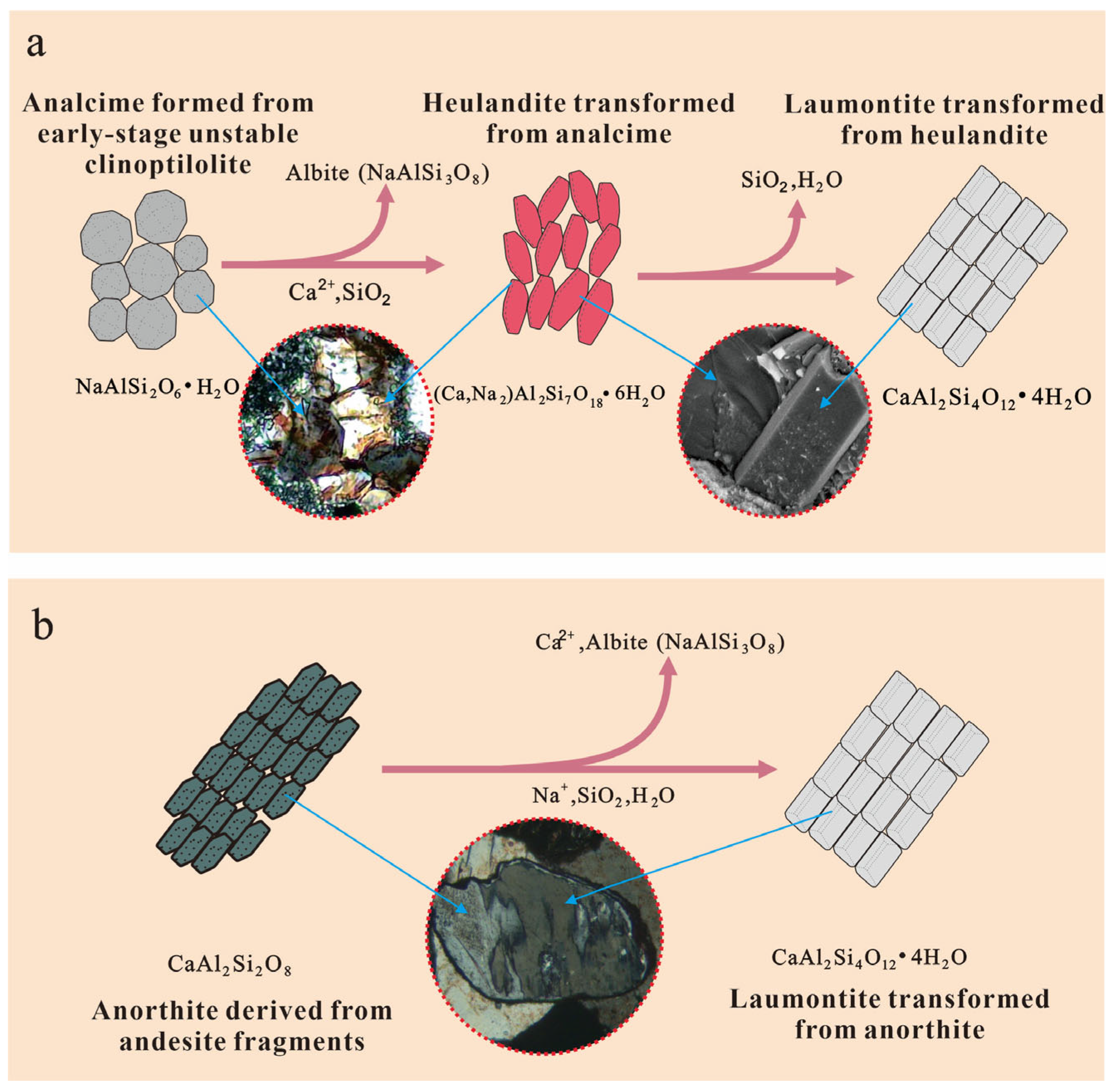
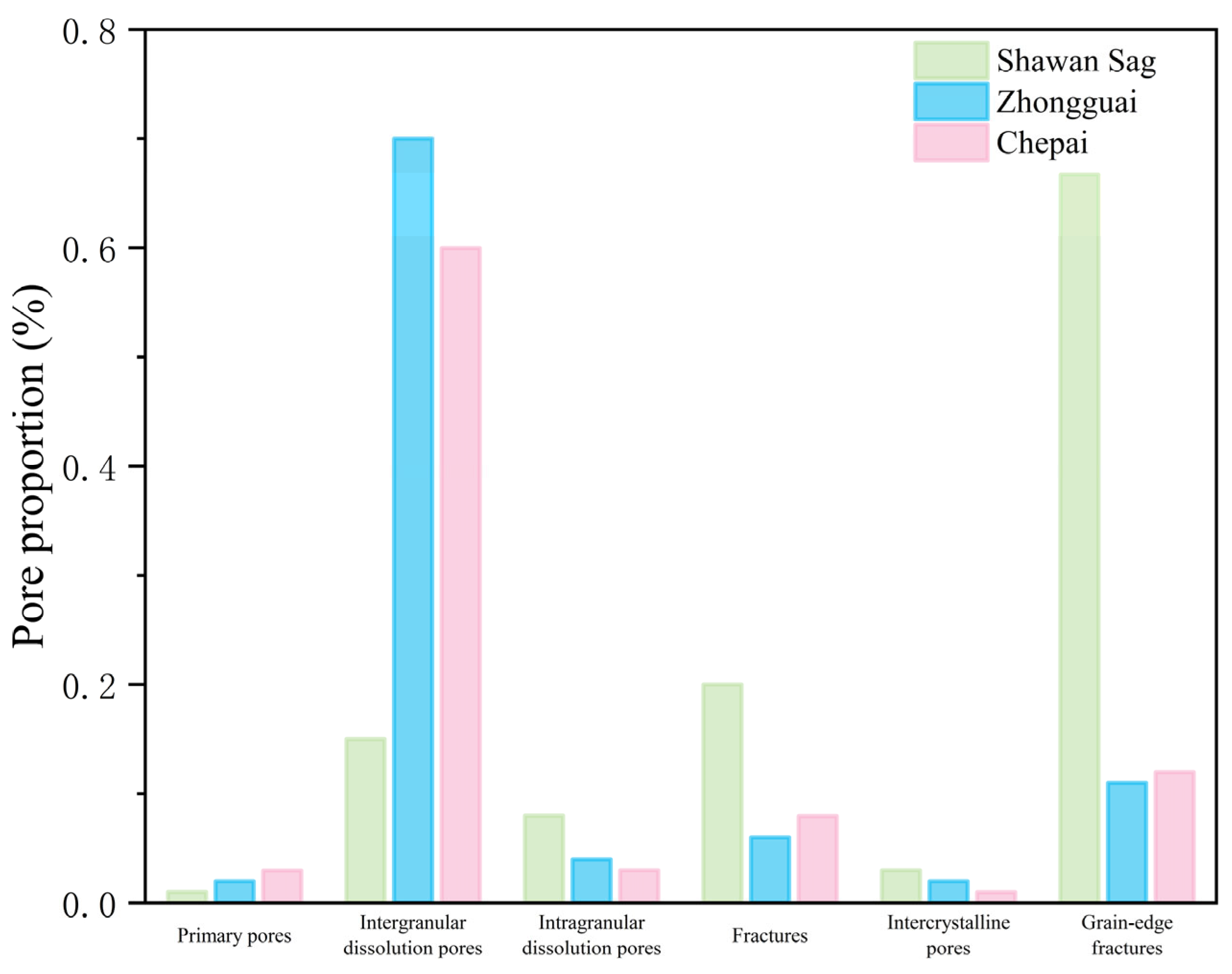
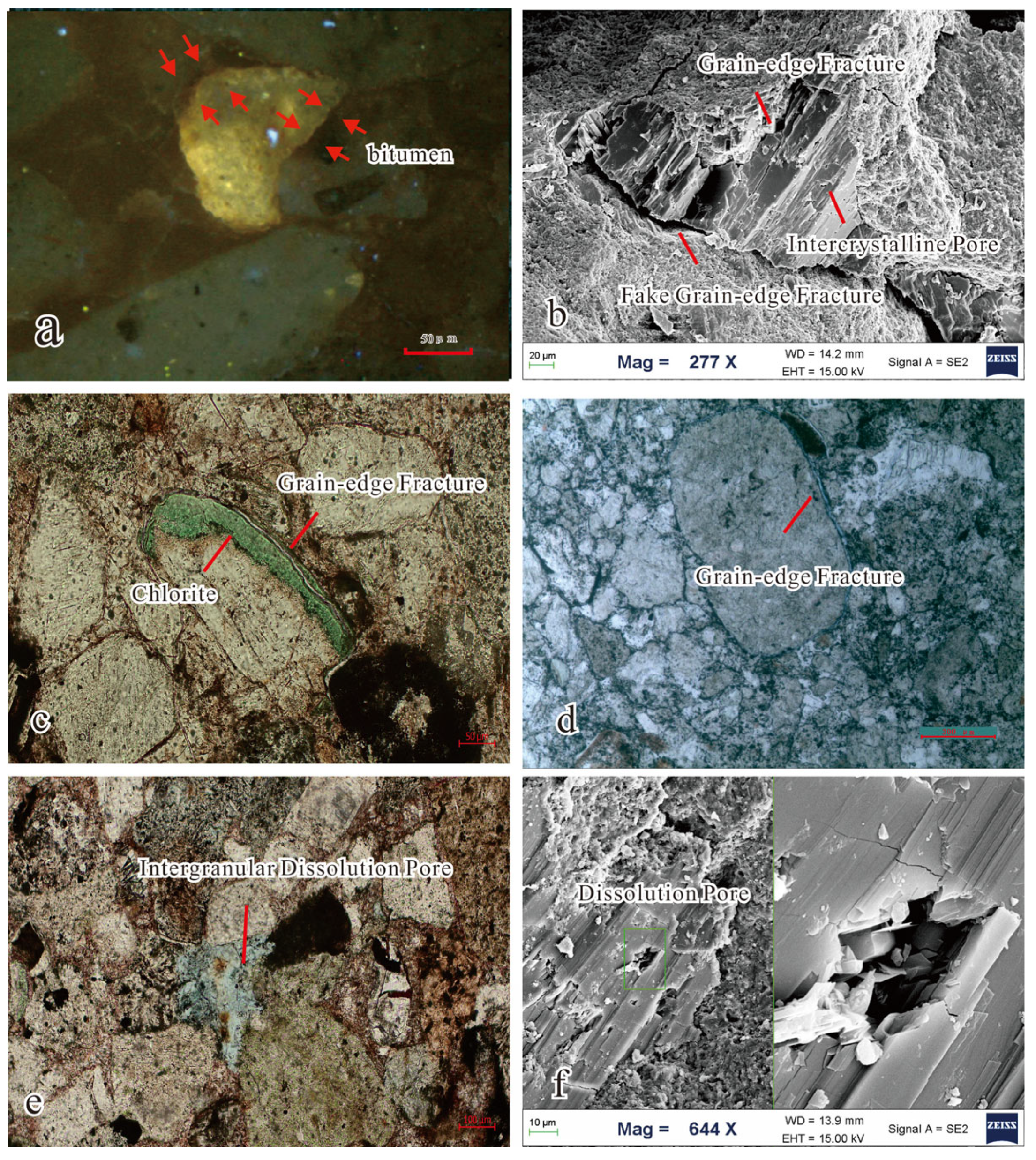
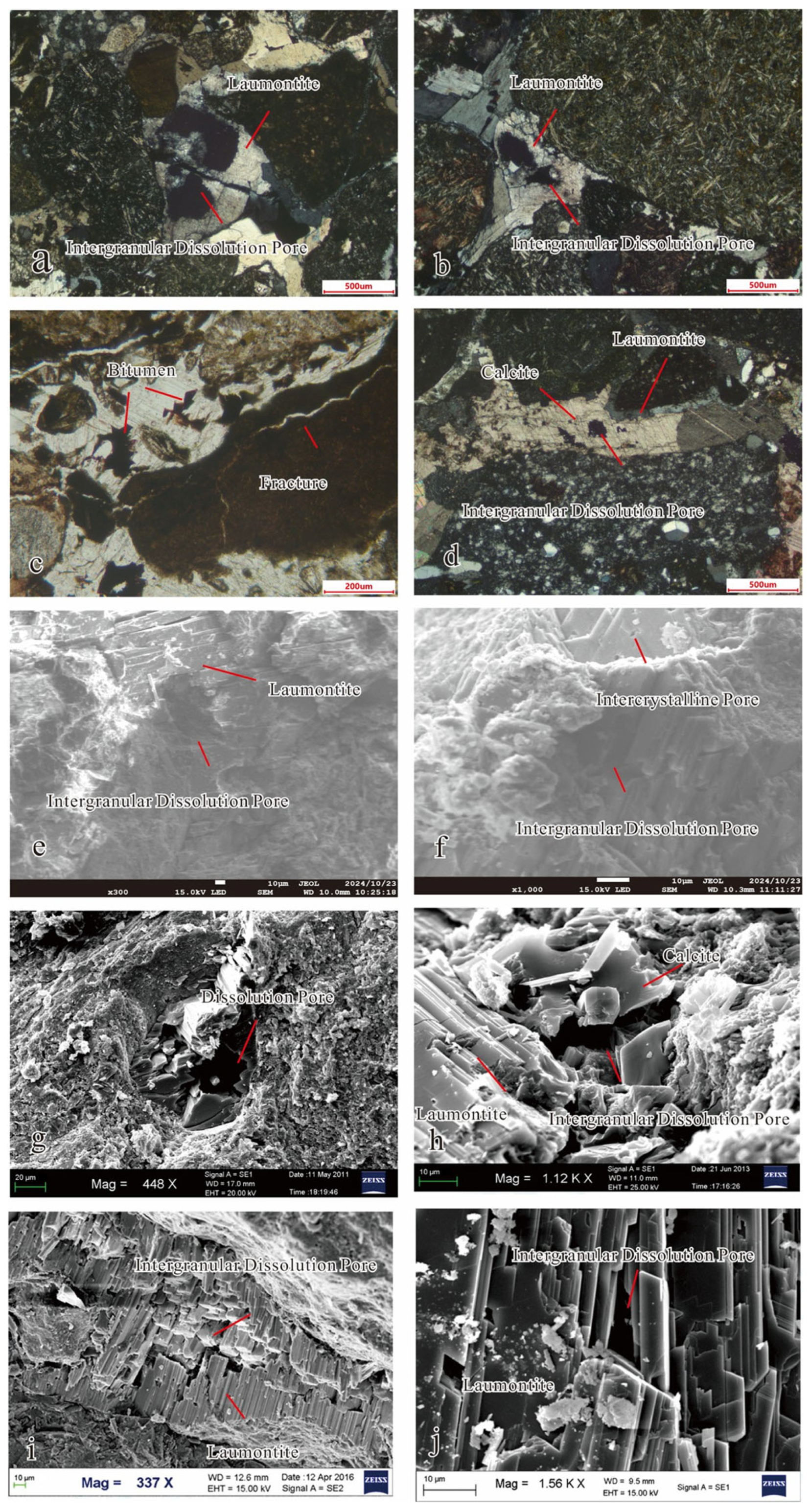
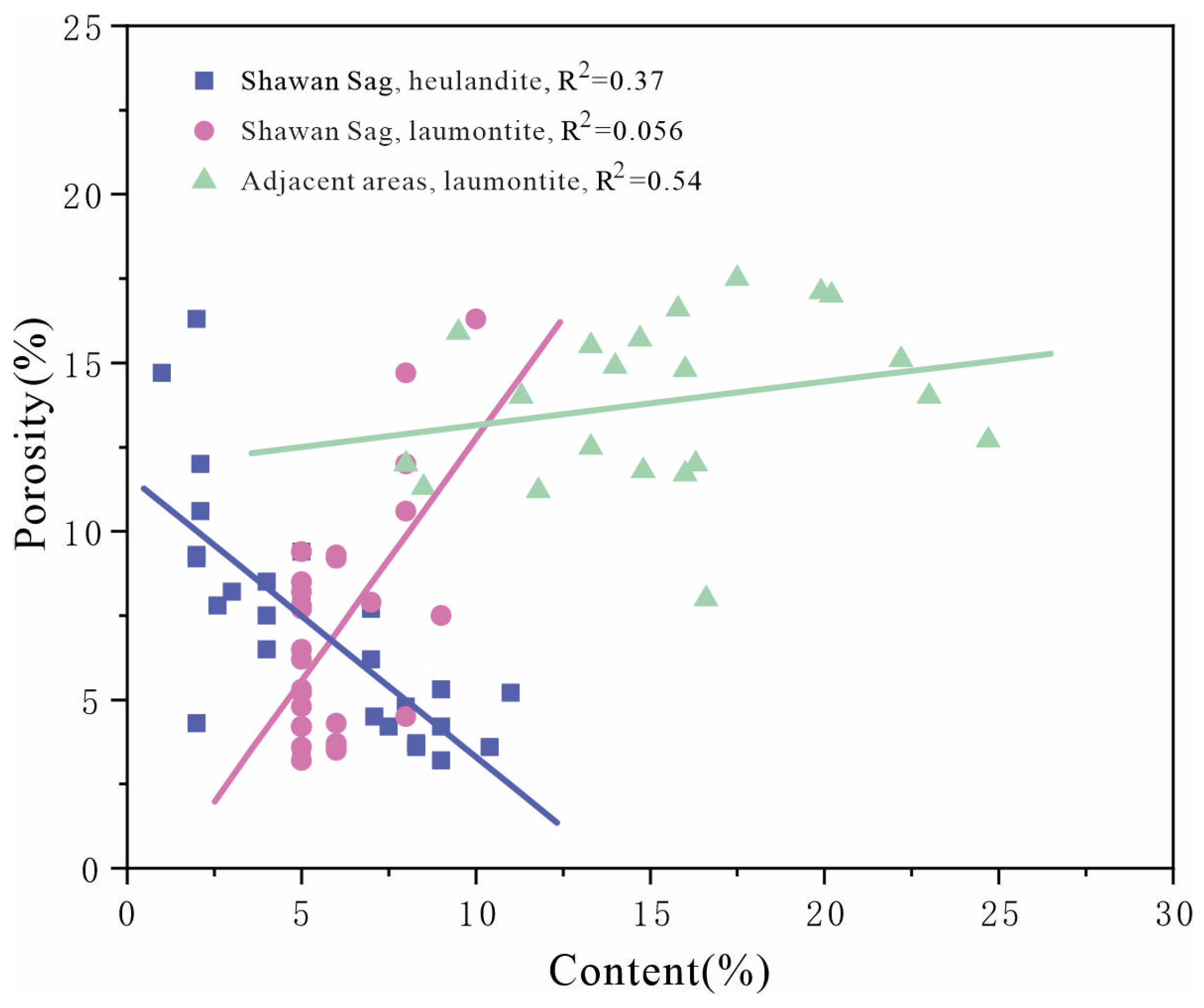

Disclaimer/Publisher’s Note: The statements, opinions and data contained in all publications are solely those of the individual author(s) and contributor(s) and not of MDPI and/or the editor(s). MDPI and/or the editor(s) disclaim responsibility for any injury to people or property resulting from any ideas, methods, instructions or products referred to in the content. |
© 2025 by the authors. Licensee MDPI, Basel, Switzerland. This article is an open access article distributed under the terms and conditions of the Creative Commons Attribution (CC BY) license (https://creativecommons.org/licenses/by/4.0/).
Share and Cite
Lv, H.; Kuang, H.; Zhang, L.; Dou, F.; Li, C.; Pan, L. Controls of Zeolite Development on Reservoir Porosity from Lower Permian Formations in Shawan and Its Adjacent Areas, Western Junggar Basin. Minerals 2025, 15, 1247. https://doi.org/10.3390/min15121247
Lv H, Kuang H, Zhang L, Dou F, Li C, Pan L. Controls of Zeolite Development on Reservoir Porosity from Lower Permian Formations in Shawan and Its Adjacent Areas, Western Junggar Basin. Minerals. 2025; 15(12):1247. https://doi.org/10.3390/min15121247
Chicago/Turabian StyleLv, Houkuan, Hao Kuang, Lei Zhang, Fangpeng Dou, Chun Li, and Lang Pan. 2025. "Controls of Zeolite Development on Reservoir Porosity from Lower Permian Formations in Shawan and Its Adjacent Areas, Western Junggar Basin" Minerals 15, no. 12: 1247. https://doi.org/10.3390/min15121247
APA StyleLv, H., Kuang, H., Zhang, L., Dou, F., Li, C., & Pan, L. (2025). Controls of Zeolite Development on Reservoir Porosity from Lower Permian Formations in Shawan and Its Adjacent Areas, Western Junggar Basin. Minerals, 15(12), 1247. https://doi.org/10.3390/min15121247





